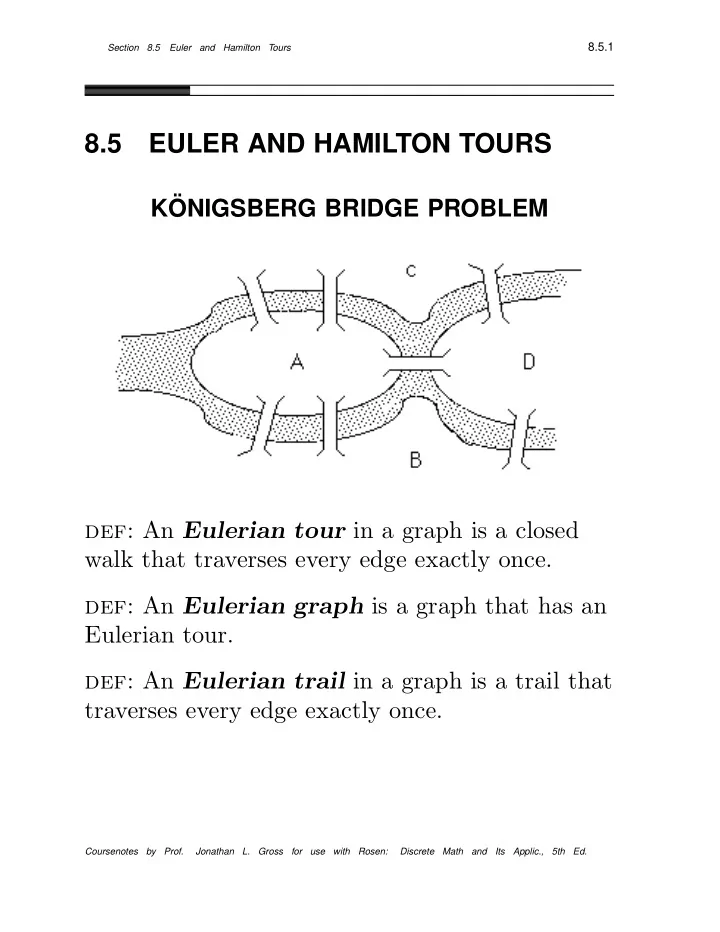

8.5.1 Section 8.5 Euler and Hamilton Tours 8.5 EULER AND HAMILTON TOURS K ¨ ONIGSBERG BRIDGE PROBLEM def: An Eulerian tour in a graph is a closed walk that traverses every edge exactly once. def: An Eulerian graph is a graph that has an Eulerian tour. def: An Eulerian trail in a graph is a trail that traverses every edge exactly once. Coursenotes by Prof. Jonathan L. Gross for use with Rosen: Discrete Math and Its Applic., 5th Ed.
8.5.2 Chapter 8 GRAPH THEORY The K¨ onigsberg graph is a non-Eulerian graph. C A D B Thm 8.5.1. A connected graph is Eulerian if and only if every vertex has even degree. sketch in class. Proof: Thm 8.5.2. A connected graph has an open Eulerian trail if and only it has exactly two vertices of odd degree. Coursenotes by Prof. Jonathan L. Gross for use with Rosen: Discrete Math and Its Applic., 5th Ed.
8.5.3 Section 8.5 Euler and Hamilton Tours CLASSROOM QUESTIONS: 1 2 4 3 5 6 7 1. Is this graph Eulerian? 2. If not, how might it it be modified to make it Eulerian? Coursenotes by Prof. Jonathan L. Gross for use with Rosen: Discrete Math and Its Applic., 5th Ed.
8.5.4 Chapter 8 GRAPH THEORY HAMILTONIAN TOURS def: A Hamiltonian tour in a graph is a cycle that visits every vertex exactly once. def: An Hamiltonian graph is a graph that has a spanning cycle. def: An Hamiltonian path in a graph is a path that visits every vertex exactly once. Coursenotes by Prof. Jonathan L. Gross for use with Rosen: Discrete Math and Its Applic., 5th Ed.
8.5.5 Section 8.5 Euler and Hamilton Tours Find a Gray code in the Example 8.5.1: hypercube. 010 110 000 100 111 011 001 101 Coursenotes by Prof. Jonathan L. Gross for use with Rosen: Discrete Math and Its Applic., 5th Ed.
8.5.6 Chapter 8 GRAPH THEORY Criterion for proving a graph is Hamiltonian. Theorem 8.5.3. (Dirac’s Theorem) Let G be a simple n -vertex graph with n ≥ 3 , such that � n � every vertex has degree at least . Then G is 2 Hamiltonian. Omitted. Proof: ♦ Dirac’s Theorem simplifies the Example 8.5.2: task of constructing all the isomorphism types of 3-regular 6-vertex simple graphs, because it implies that every one of them has a complete spanning cycle. There are only these two. Coursenotes by Prof. Jonathan L. Gross for use with Rosen: Discrete Math and Its Applic., 5th Ed.
8.5.7 Section 8.5 Euler and Hamilton Tours Rules for proving a graph is not Hamiltonian. (1) If a vertex v has degree two, then both its incident edges must lie on a Hamiltonian cycle, if there is one. (2) If two edges incident on a vertex are required in the construction of a Hamilton cycle, then all the others can be deleted without changing the Hamiltonicity of the graph. (3) If a cycle formed from required edges is not a spanning cycle, then there is no spanning cycle. (4) A Hamilton graph has no cutpoints. Example 8.5.3: Example 8.5.4: Coursenotes by Prof. Jonathan L. Gross for use with Rosen: Discrete Math and Its Applic., 5th Ed.
Recommend
More recommend